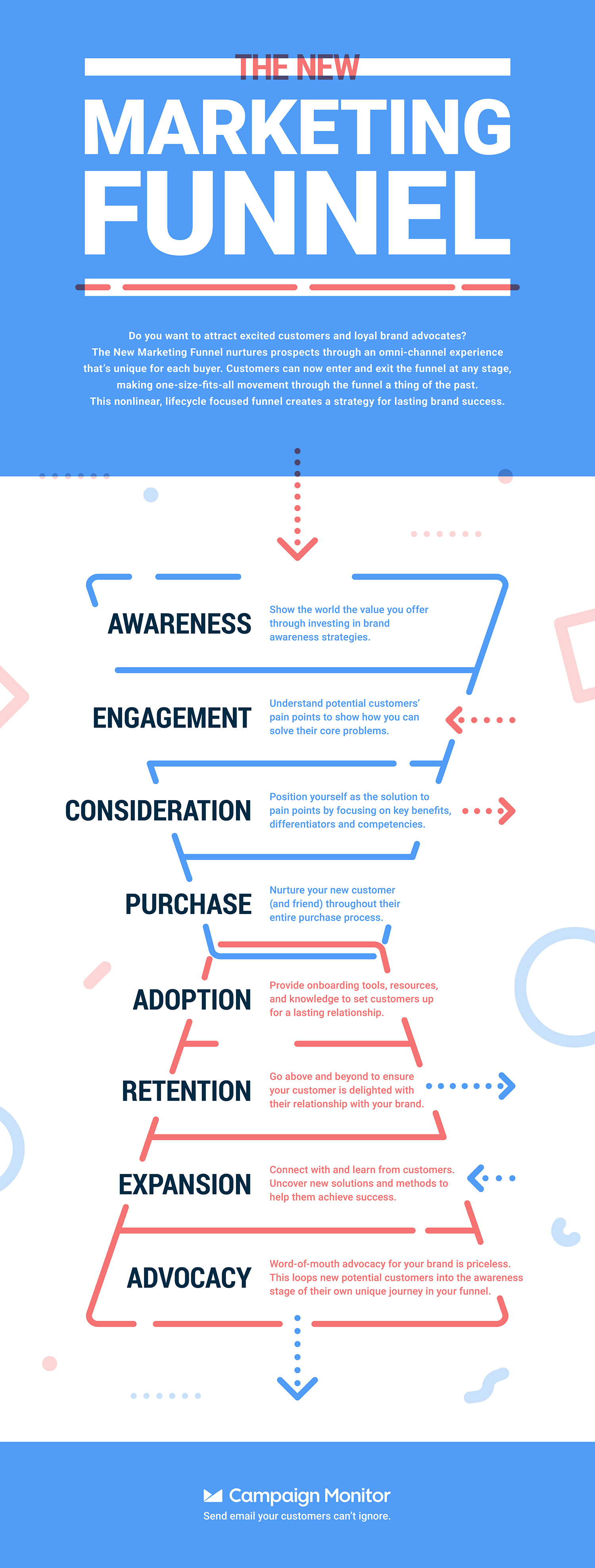A New Marketing Funnel Is Taking Over [Infographic]

A new marketing funnel is taking over, and it’s completely different from the one you are or were familiar with.
For decades, marketers patterned and built their strategies on the linear funnel where there’s only one entrance (brand awareness) and exit (conversion) point throughout the purchasing journey. The primary goal was to acquire leads and lead them all the way down to the funnel. Once you purchase something, you’re basically on your own. No onboarding tools, customer retention content and post-purchase tactics. Nada.
However, with the emergence of new tools and tactics, you can expect more than just an electronic copy of your receipt in your inbox.
Chances are, you’re already familiar with this change. When was the last time you purchased from a shop you haven’t heard of before, but because of good customer feedback and reviews, you’re now a customer? Alternatively, when did you re-subscribe to a newsletter because of new member-exclusive content and discount? This behavior, as you might have noticed, is non-linear.
You didn’t purchase because you know the brand, but because of recommendations. You didn’t subscribe because you are a new customer, but because of an enticing deal or amazing customer service. The new marketing funnel, which is now more of an hourglass, recognizes this new purchasing pattern and experience and offers a more realistic process for today’s customer journey.
As a marketer, this new marketing funnel allows you to influence the behavior of new and existing customers at any stage throughout the entire buying journey. However, how do you apply this new strategy for your campaign? Learning each stage of the new marketing funnel is the first step. Here’s how the new funnel works:
Source: https://www.campaignmonitor.com/resources/infographics/the-new-marketing-funnel
1. Establish brand awareness
Similar to its predecessor, the new funnel starts with brand awareness. You can consider it the “get to know each other” stage. Prospects will learn more about your brand by reading valuable information like company profile and frequently asked questions (FAQ). Brand-awareness strategies like online ads and Search Engine Optimization can attract and drive customers to your website.
2. Understand prospects’ pain points
Now that you’ve caught the attention of prospects, the next stage is understanding their pain points and concerns. For example, they had a terrible refund claim experience from a competitor. Use that information to detail and emphasize the warranty and exchange policy of your brand. Prospects can exit the funnel at this point.
3. Show what you can offer
You can now present product-specific content that is based on the acquired customer pain points information. Focus and highlight brand advantages – not only on the features and specifications. For a more active approach, use targeted content for a specific and personalized experience.
4. Make purchasing easy
During this phase, make sure to provide them with a smooth and streamlined buying procedure. Have your customer service department ready just in case there is a problem or if they have payment method-related questions and concerns.
5. Build the foundation of customer relationship
A conversion doesn’t mean you have to leave customers on their own. Rather, you must nurture them. You can offer tools and resources per the product or service they availed. By doing so, you can lay the foundation of a long-lasting customer relationship.
6. Keep them engaged
Once you have the foundation, it is now time to build the relationship. Go above and beyond by offering content valuable to them. Use customer information like buying behavior and demographics and develop targeted content. At this stage, can exit the funnel.
7. Expand your tactics and strategies
What might have worked before, may not be applicable in two months’ time. Always keep-up-to-date with the latest marketing strategy, uncover customer pain points, and offer a solution. You can get the attention of new leads and even previous customers that opted out during the retention stage.
8. Build brand advocacy
Advocacy is the final stage of the new marketing funnel. At this stage, customers have become fans. They are your brand ambassadors. They share positive reviews and feedback and even refer you to their friends and families.
Wrap Up
In a highly saturated and competitive online environment, making a sale and calling it a day isn’t going to cut it anymore. You need to extend your efforts in making sure you just don’t acquire leads or make a conversion. You have to nurture leads and longtime consumers so they can keep coming back to you.
Is there anything you would like to add to the above? Please leave your comments, below. Thanks!
You may also want to read: Why Sales Funnels Are So Effective for Online Marketing
For Happy Customers, Look Beyond the Sales Funnel
 Jericho Gonzales is a Content Marketing Specialist at Campaign Monitor. After seven years of being unhappy with his career in the financial industry, he decided to follow his dreams and become a writer. Besides writing, he is also passionate about all kinds of martial arts and practices whenever he can. You can join his LinkedIn network here.
Jericho Gonzales is a Content Marketing Specialist at Campaign Monitor. After seven years of being unhappy with his career in the financial industry, he decided to follow his dreams and become a writer. Besides writing, he is also passionate about all kinds of martial arts and practices whenever he can. You can join his LinkedIn network here.
Featured image: Copyright: ‘https://www.123rf.com/profile_mrtelovek‘ / 123RF Stock Photo
To receive more videos, in-depth articles and Infographics in your inbox, please sign up below

Sign up for the newest articles from Curatti, delivered straight to your inbox

CURATTI GUEST


